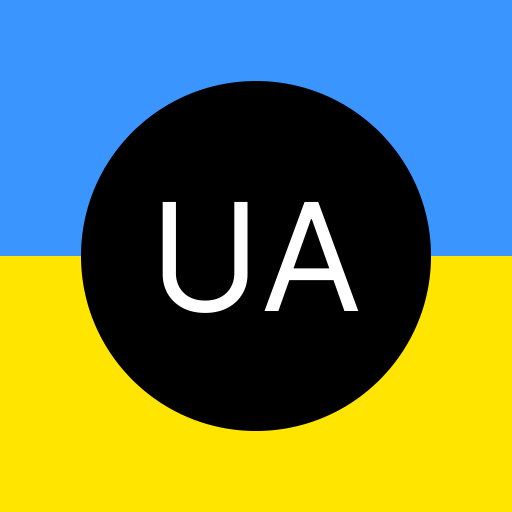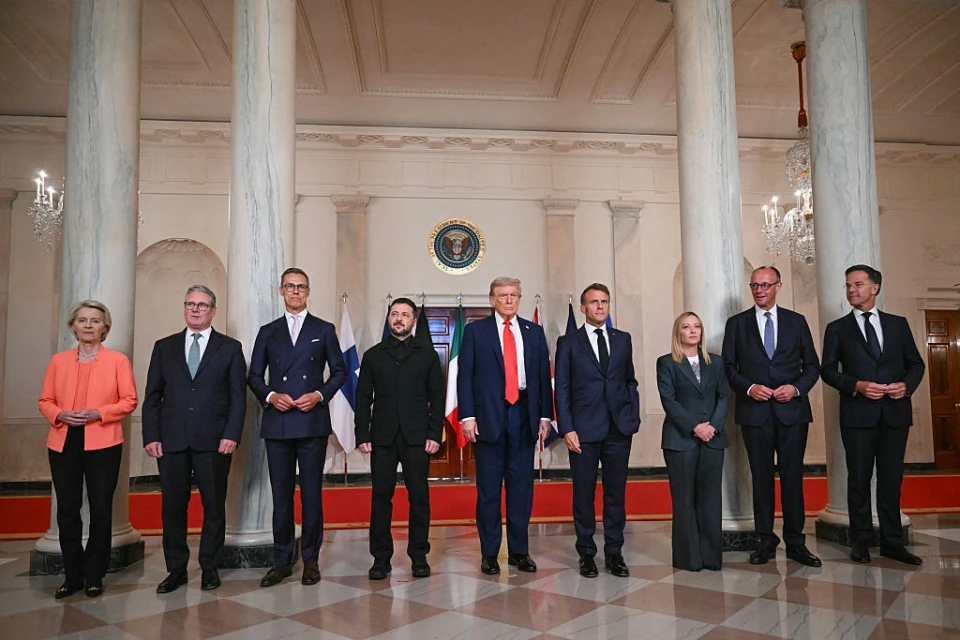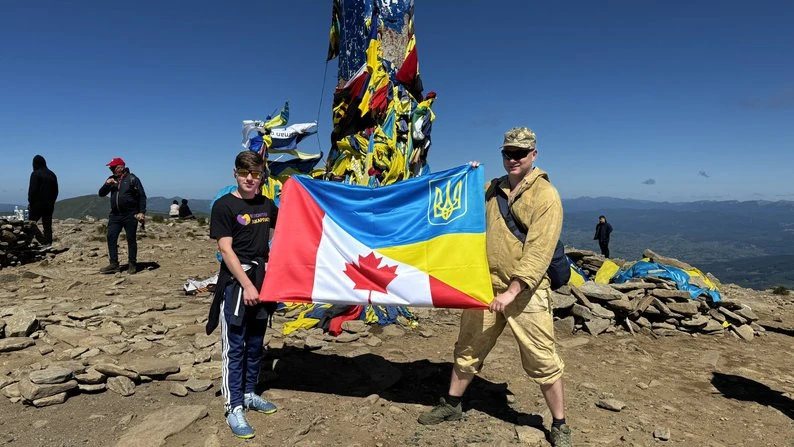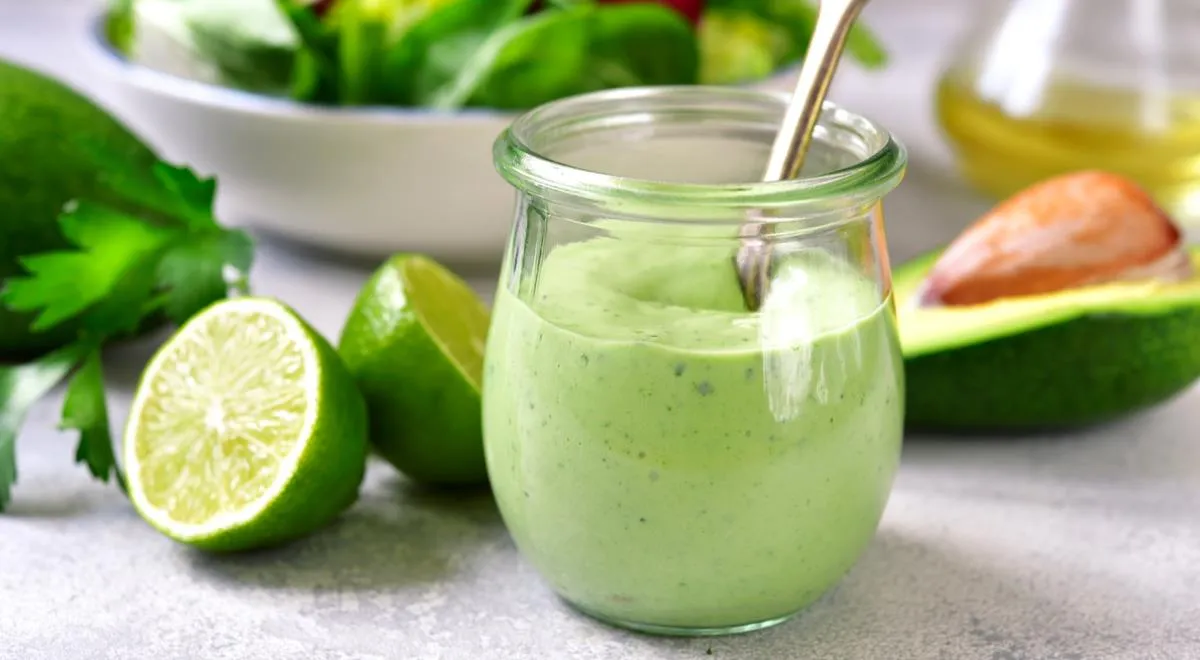Security guarantees for Ukraine: are there options beyond NATO? Pt. 2
global.espreso.tv
Mon, 25 Aug 2025 14:56:00 +0300

Contents1. Why does Russia “haunt” NATO but not touch the North Atlantic Treaty?2. How to force Russia to abandon the goals of its “special military operation”3. How NATO’s guarantees for Eastern Europe are structured4. How Ukraine’s flank could be organized outside NATOIn the article Security guarantees for Ukraine: options beyond NATO we noted the outcome of the meeting in Washington involving the presidents of the U.S., Ukraine, European leaders, NATO, and the EU. We examined possible components of security guarantees for Ukraine and how they could become part of Europe’s common system. But no less relevant remain the legal, organizational, and defense aspects themselves. Let’s focus on this.Why does Russia “haunt” NATO but not touch the North Atlantic Treaty?To answer complex questions, we need a little patience. Let’s look at a few paragraphs of text that may seem somewhat academic at first glance.In international practice, there are many treaties in which states promise one another help in critical situations. Classic examples include Article V of the 1948 Brussels Treaty, which laid the foundation of the Western European Union, as well as mutual assistance provisions in EU law: Article 42(7) of the Treaty on European Union and Article 222 of the Treaty on the Functioning of the EU. Another category consists of U.S. bilateral agreements with Japan, South Korea, Australia, and several Gulf countries: not multilateral organizations but guarantees rooted in American alliance commitments.NATO, however, is not just the North Atlantic (Washington) Treaty of 1949 containing mutual assistance provisions. Crucially, it is also the North Atlantic Treaty Organization. That is why, even in the throes of its “Russian World” rhetoric, Russia never demanded cancellation of the Treaty itself. Simply because it does not see the text as a threat — just as it doesn’t see the Budapest Memorandum as one. What Russia has always demanded, everywhere, is the dissolution of NATO — because the Alliance can almost automatically implement what is written in the Treaty.The first real attempt to form a continental defense treaty was the Western European Union (WEU), created by the 1948 Brussels Treaty. It became the forerunner of NATO: in 1949, the North Atlantic Treaty entered into force, and in 1952 the Organization was established, i.e. NATO itself. It took over the military functions of the WEU. In subsequent decades, the remnants of the WEU were gradually integrated into EU institutions, and its key ideas, including mutual defense, were reflected in EU security provisions.NATO is not the only treaty-based organization, but it remains the only military alliance today built on a collective defense treaty of shared values.We can compare this to other structures: the UN is based on its 1945 Charter; the OSCE on the 1975 Helsinki Final Act; the CSTO on the 1992 Tashkent Treaty. But these are political, economic, or general security formats — and all are far weaker than a military alliance. Words in a treaty, whatever the name, have little force if the organization is weak or absent. According to the 1969 Vienna Convention on the Law of Treaties, any written agreement between states governed by international law is a treaty, regardless of whether it is called a convention, pact, protocol, or memorandum. The name signals solemnity or political context, but does not automatically determine enforceability or mechanisms of action.Thus, the text of Article 5 of the NATO Treaty contains nothing fundamentally different in form from the 1994 Budapest Memorandum. In that sense, the Memorandum is a valid international treaty. Its weakness lies not in the name but in the lack of an enforcement mechanism or organization ensuring a guaranteed reaction. Without institutions, planning, forces, and decision-making centers, promises remain intentions rather than deterrents. This difference between paper wording and real organization is key when discussing Ukraine’s future guarantees.How to force Russia to abandon the goals of its “special military operation”Reliable security guarantees can exist outside NATO, but they must be organized in a NATO-like way. Has the Kremlin realized that lasting peace after this war is impossible without effective international guarantees for Ukraine — not necessarily under NATO (if Russia rejects the word), but equivalent to NATO? Donald Trump said Putin agreed. But we know there is still strong resistance within Russia’s power structure to granting Ukraine real guarantees.Does this resistance mean it cannot be overcome? Probably not — otherwise negotiations wouldn’t be continuing, but they are. The form of guarantees will depend on Russia’s final conditions for ending the war. What Russia seems to have realized, though not publicly admitting, is that lasting peace is impossible without acknowledging the unattainability of its “special military operation goals”: destroying Ukrainian sovereignty and dismantling Europe’s security architecture. This is not a negotiation issue but a recognition of facts.History offers a precedent. In 1986, Soviet leader Gorbachev, by meeting Ronald Reagan in Iceland, acknowledged the USSR’s Cold War goals — destroying global capitalism — were unattainable. That recognition triggered the process that ended the Cold War.
Words in a treaty, whatever the name, have little force if the organization is weak or absent. According to the 1969 Vienna Convention on the Law of Treaties, any written agreement between states governed by international law is a treaty, regardless of whether it is called a convention, pact, protocol, or memorandum. The name signals solemnity or political context, but does not automatically determine enforceability or mechanisms of action.Thus, the text of Article 5 of the NATO Treaty contains nothing fundamentally different in form from the 1994 Budapest Memorandum. In that sense, the Memorandum is a valid international treaty. Its weakness lies not in the name but in the lack of an enforcement mechanism or organization ensuring a guaranteed reaction. Without institutions, planning, forces, and decision-making centers, promises remain intentions rather than deterrents. This difference between paper wording and real organization is key when discussing Ukraine’s future guarantees.How to force Russia to abandon the goals of its “special military operation”Reliable security guarantees can exist outside NATO, but they must be organized in a NATO-like way. Has the Kremlin realized that lasting peace after this war is impossible without effective international guarantees for Ukraine — not necessarily under NATO (if Russia rejects the word), but equivalent to NATO? Donald Trump said Putin agreed. But we know there is still strong resistance within Russia’s power structure to granting Ukraine real guarantees.Does this resistance mean it cannot be overcome? Probably not — otherwise negotiations wouldn’t be continuing, but they are. The form of guarantees will depend on Russia’s final conditions for ending the war. What Russia seems to have realized, though not publicly admitting, is that lasting peace is impossible without acknowledging the unattainability of its “special military operation goals”: destroying Ukrainian sovereignty and dismantling Europe’s security architecture. This is not a negotiation issue but a recognition of facts.History offers a precedent. In 1986, Soviet leader Gorbachev, by meeting Ronald Reagan in Iceland, acknowledged the USSR’s Cold War goals — destroying global capitalism — were unattainable. That recognition triggered the process that ended the Cold War. So, the form of Russia’s recognition doesn’t matter: it could be an “eternal peace treaty,” a sudden “fulfillment of all goals,” or an acknowledgment of historical responsibility. What matters is that it happens quickly, as Trump stresses. Moscow gains nothing by delay — its goals will remain unattainable by Putin’s birthday or New Year alike. Security guarantees for Ukraine will be part of any deal to end the war, but their form will depend on how the Kremlin accepts defeat.If Russia freezes the front where it stands now, guarantees could take the shape of an “improved Budapest Memorandum”: stronger wording, perhaps ratified, but most importantly coupled with military aid enabling Ukraine to resist any future aggression.If Russia tries to push further, especially toward central Ukraine’s resource-rich regions, only NATO-level guarantees would be sufficient.How NATO’s guarantees for Eastern Europe are structuredAfter Russia’s 2014 invasion, NATO transformed Article 5 from promises into forces. At the 2016 Warsaw Summit, NATO deployed multinational battlegroups in Poland and the Baltics, each led by a framework nation (U.S. in Poland, UK in Estonia, Canada in Latvia, Germany in Lithuania). After 2022, this expanded to eight groups including Bulgaria, Hungary, Romania, and Slovakia. In 2024–2025, Latvia scaled up to a brigade; Germany is doing so in Lithuania.NATO Force Integration Units (NFIU) serve as small HQs in eight frontline countries, ensuring rapid deployment of allied forces, integrating them into national defenses.Air policing has run 24/7 since 2004 in the Baltics, with new missions in Romania, Bulgaria, and a wider Air Shielding program since 2022. US F-22s have deployed to Poland, alongside rotating allied jets.Poland has become NATO’s eastern hub: hosting a U.S. Fifth Army Corps forward HQ, permanent American garrisons, and allied aircraft rotations. Its own air force is expanding with F-16s, FA-50s, and soon F-35s.In the Black Sea, France leads the multinational group in Romania, with units armed with systems like SAMP/T MAMBA. Joint training integrates artillery and air defense into NATO’s collective defense.How Ukraine’s flank could be organized outside NATOBased on NATO’s eastern flank model, international presence in Ukraine could be structured after the war to deter future Russian aggression.
So, the form of Russia’s recognition doesn’t matter: it could be an “eternal peace treaty,” a sudden “fulfillment of all goals,” or an acknowledgment of historical responsibility. What matters is that it happens quickly, as Trump stresses. Moscow gains nothing by delay — its goals will remain unattainable by Putin’s birthday or New Year alike. Security guarantees for Ukraine will be part of any deal to end the war, but their form will depend on how the Kremlin accepts defeat.If Russia freezes the front where it stands now, guarantees could take the shape of an “improved Budapest Memorandum”: stronger wording, perhaps ratified, but most importantly coupled with military aid enabling Ukraine to resist any future aggression.If Russia tries to push further, especially toward central Ukraine’s resource-rich regions, only NATO-level guarantees would be sufficient.How NATO’s guarantees for Eastern Europe are structuredAfter Russia’s 2014 invasion, NATO transformed Article 5 from promises into forces. At the 2016 Warsaw Summit, NATO deployed multinational battlegroups in Poland and the Baltics, each led by a framework nation (U.S. in Poland, UK in Estonia, Canada in Latvia, Germany in Lithuania). After 2022, this expanded to eight groups including Bulgaria, Hungary, Romania, and Slovakia. In 2024–2025, Latvia scaled up to a brigade; Germany is doing so in Lithuania.NATO Force Integration Units (NFIU) serve as small HQs in eight frontline countries, ensuring rapid deployment of allied forces, integrating them into national defenses.Air policing has run 24/7 since 2004 in the Baltics, with new missions in Romania, Bulgaria, and a wider Air Shielding program since 2022. US F-22s have deployed to Poland, alongside rotating allied jets.Poland has become NATO’s eastern hub: hosting a U.S. Fifth Army Corps forward HQ, permanent American garrisons, and allied aircraft rotations. Its own air force is expanding with F-16s, FA-50s, and soon F-35s.In the Black Sea, France leads the multinational group in Romania, with units armed with systems like SAMP/T MAMBA. Joint training integrates artillery and air defense into NATO’s collective defense.How Ukraine’s flank could be organized outside NATOBased on NATO’s eastern flank model, international presence in Ukraine could be structured after the war to deter future Russian aggression. Polish model: Ukraine maintains ~450,000 troops; ~15–20,000 allied personnel (under 5%); 120–150 Ukrainian fighters plus 12–18 allied jets.Romanian model: ~350,000 Ukrainians; ~25–30,000 allies (6–8%); 100–120 Ukrainian fighters plus 25–35 allied aircraft; major naval component using ports and Black Sea coordination.Baltic model: ~200,000 Ukrainians; ~40–50,000 allies (25%); 80–100 Ukrainian fighters plus 50–60 allied jets; maximal integration but less autonomy.Most realistic is a synthetic model blending Polish and Romanian logics: ~400,000 Ukrainian troops, ~20–25,000 allied personnel, ~100–120 Ukrainian aircraft supported by 20–30 allied planes, plus Black Sea joint presence in Odesa and Pivdennyi with Romania and Bulgaria.Such a balance would preserve Ukraine’s autonomy in decision-making while making international collective reaction mechanisms credible and effective.This material was prepared in cooperation with the Consortium for Defense Information (CDI), a project uniting Ukrainian analytical and research organizations with the goal of strengthening information support and analytical capacity in the areas of national security, defense, and geopolitics.
Polish model: Ukraine maintains ~450,000 troops; ~15–20,000 allied personnel (under 5%); 120–150 Ukrainian fighters plus 12–18 allied jets.Romanian model: ~350,000 Ukrainians; ~25–30,000 allies (6–8%); 100–120 Ukrainian fighters plus 25–35 allied aircraft; major naval component using ports and Black Sea coordination.Baltic model: ~200,000 Ukrainians; ~40–50,000 allies (25%); 80–100 Ukrainian fighters plus 50–60 allied jets; maximal integration but less autonomy.Most realistic is a synthetic model blending Polish and Romanian logics: ~400,000 Ukrainian troops, ~20–25,000 allied personnel, ~100–120 Ukrainian aircraft supported by 20–30 allied planes, plus Black Sea joint presence in Odesa and Pivdennyi with Romania and Bulgaria.Such a balance would preserve Ukraine’s autonomy in decision-making while making international collective reaction mechanisms credible and effective.This material was prepared in cooperation with the Consortium for Defense Information (CDI), a project uniting Ukrainian analytical and research organizations with the goal of strengthening information support and analytical capacity in the areas of national security, defense, and geopolitics.
 Words in a treaty, whatever the name, have little force if the organization is weak or absent. According to the 1969 Vienna Convention on the Law of Treaties, any written agreement between states governed by international law is a treaty, regardless of whether it is called a convention, pact, protocol, or memorandum. The name signals solemnity or political context, but does not automatically determine enforceability or mechanisms of action.Thus, the text of Article 5 of the NATO Treaty contains nothing fundamentally different in form from the 1994 Budapest Memorandum. In that sense, the Memorandum is a valid international treaty. Its weakness lies not in the name but in the lack of an enforcement mechanism or organization ensuring a guaranteed reaction. Without institutions, planning, forces, and decision-making centers, promises remain intentions rather than deterrents. This difference between paper wording and real organization is key when discussing Ukraine’s future guarantees.How to force Russia to abandon the goals of its “special military operation”Reliable security guarantees can exist outside NATO, but they must be organized in a NATO-like way. Has the Kremlin realized that lasting peace after this war is impossible without effective international guarantees for Ukraine — not necessarily under NATO (if Russia rejects the word), but equivalent to NATO? Donald Trump said Putin agreed. But we know there is still strong resistance within Russia’s power structure to granting Ukraine real guarantees.Does this resistance mean it cannot be overcome? Probably not — otherwise negotiations wouldn’t be continuing, but they are. The form of guarantees will depend on Russia’s final conditions for ending the war. What Russia seems to have realized, though not publicly admitting, is that lasting peace is impossible without acknowledging the unattainability of its “special military operation goals”: destroying Ukrainian sovereignty and dismantling Europe’s security architecture. This is not a negotiation issue but a recognition of facts.History offers a precedent. In 1986, Soviet leader Gorbachev, by meeting Ronald Reagan in Iceland, acknowledged the USSR’s Cold War goals — destroying global capitalism — were unattainable. That recognition triggered the process that ended the Cold War.
Words in a treaty, whatever the name, have little force if the organization is weak or absent. According to the 1969 Vienna Convention on the Law of Treaties, any written agreement between states governed by international law is a treaty, regardless of whether it is called a convention, pact, protocol, or memorandum. The name signals solemnity or political context, but does not automatically determine enforceability or mechanisms of action.Thus, the text of Article 5 of the NATO Treaty contains nothing fundamentally different in form from the 1994 Budapest Memorandum. In that sense, the Memorandum is a valid international treaty. Its weakness lies not in the name but in the lack of an enforcement mechanism or organization ensuring a guaranteed reaction. Without institutions, planning, forces, and decision-making centers, promises remain intentions rather than deterrents. This difference between paper wording and real organization is key when discussing Ukraine’s future guarantees.How to force Russia to abandon the goals of its “special military operation”Reliable security guarantees can exist outside NATO, but they must be organized in a NATO-like way. Has the Kremlin realized that lasting peace after this war is impossible without effective international guarantees for Ukraine — not necessarily under NATO (if Russia rejects the word), but equivalent to NATO? Donald Trump said Putin agreed. But we know there is still strong resistance within Russia’s power structure to granting Ukraine real guarantees.Does this resistance mean it cannot be overcome? Probably not — otherwise negotiations wouldn’t be continuing, but they are. The form of guarantees will depend on Russia’s final conditions for ending the war. What Russia seems to have realized, though not publicly admitting, is that lasting peace is impossible without acknowledging the unattainability of its “special military operation goals”: destroying Ukrainian sovereignty and dismantling Europe’s security architecture. This is not a negotiation issue but a recognition of facts.History offers a precedent. In 1986, Soviet leader Gorbachev, by meeting Ronald Reagan in Iceland, acknowledged the USSR’s Cold War goals — destroying global capitalism — were unattainable. That recognition triggered the process that ended the Cold War. So, the form of Russia’s recognition doesn’t matter: it could be an “eternal peace treaty,” a sudden “fulfillment of all goals,” or an acknowledgment of historical responsibility. What matters is that it happens quickly, as Trump stresses. Moscow gains nothing by delay — its goals will remain unattainable by Putin’s birthday or New Year alike. Security guarantees for Ukraine will be part of any deal to end the war, but their form will depend on how the Kremlin accepts defeat.If Russia freezes the front where it stands now, guarantees could take the shape of an “improved Budapest Memorandum”: stronger wording, perhaps ratified, but most importantly coupled with military aid enabling Ukraine to resist any future aggression.If Russia tries to push further, especially toward central Ukraine’s resource-rich regions, only NATO-level guarantees would be sufficient.How NATO’s guarantees for Eastern Europe are structuredAfter Russia’s 2014 invasion, NATO transformed Article 5 from promises into forces. At the 2016 Warsaw Summit, NATO deployed multinational battlegroups in Poland and the Baltics, each led by a framework nation (U.S. in Poland, UK in Estonia, Canada in Latvia, Germany in Lithuania). After 2022, this expanded to eight groups including Bulgaria, Hungary, Romania, and Slovakia. In 2024–2025, Latvia scaled up to a brigade; Germany is doing so in Lithuania.NATO Force Integration Units (NFIU) serve as small HQs in eight frontline countries, ensuring rapid deployment of allied forces, integrating them into national defenses.Air policing has run 24/7 since 2004 in the Baltics, with new missions in Romania, Bulgaria, and a wider Air Shielding program since 2022. US F-22s have deployed to Poland, alongside rotating allied jets.Poland has become NATO’s eastern hub: hosting a U.S. Fifth Army Corps forward HQ, permanent American garrisons, and allied aircraft rotations. Its own air force is expanding with F-16s, FA-50s, and soon F-35s.In the Black Sea, France leads the multinational group in Romania, with units armed with systems like SAMP/T MAMBA. Joint training integrates artillery and air defense into NATO’s collective defense.How Ukraine’s flank could be organized outside NATOBased on NATO’s eastern flank model, international presence in Ukraine could be structured after the war to deter future Russian aggression.
So, the form of Russia’s recognition doesn’t matter: it could be an “eternal peace treaty,” a sudden “fulfillment of all goals,” or an acknowledgment of historical responsibility. What matters is that it happens quickly, as Trump stresses. Moscow gains nothing by delay — its goals will remain unattainable by Putin’s birthday or New Year alike. Security guarantees for Ukraine will be part of any deal to end the war, but their form will depend on how the Kremlin accepts defeat.If Russia freezes the front where it stands now, guarantees could take the shape of an “improved Budapest Memorandum”: stronger wording, perhaps ratified, but most importantly coupled with military aid enabling Ukraine to resist any future aggression.If Russia tries to push further, especially toward central Ukraine’s resource-rich regions, only NATO-level guarantees would be sufficient.How NATO’s guarantees for Eastern Europe are structuredAfter Russia’s 2014 invasion, NATO transformed Article 5 from promises into forces. At the 2016 Warsaw Summit, NATO deployed multinational battlegroups in Poland and the Baltics, each led by a framework nation (U.S. in Poland, UK in Estonia, Canada in Latvia, Germany in Lithuania). After 2022, this expanded to eight groups including Bulgaria, Hungary, Romania, and Slovakia. In 2024–2025, Latvia scaled up to a brigade; Germany is doing so in Lithuania.NATO Force Integration Units (NFIU) serve as small HQs in eight frontline countries, ensuring rapid deployment of allied forces, integrating them into national defenses.Air policing has run 24/7 since 2004 in the Baltics, with new missions in Romania, Bulgaria, and a wider Air Shielding program since 2022. US F-22s have deployed to Poland, alongside rotating allied jets.Poland has become NATO’s eastern hub: hosting a U.S. Fifth Army Corps forward HQ, permanent American garrisons, and allied aircraft rotations. Its own air force is expanding with F-16s, FA-50s, and soon F-35s.In the Black Sea, France leads the multinational group in Romania, with units armed with systems like SAMP/T MAMBA. Joint training integrates artillery and air defense into NATO’s collective defense.How Ukraine’s flank could be organized outside NATOBased on NATO’s eastern flank model, international presence in Ukraine could be structured after the war to deter future Russian aggression. Polish model: Ukraine maintains ~450,000 troops; ~15–20,000 allied personnel (under 5%); 120–150 Ukrainian fighters plus 12–18 allied jets.Romanian model: ~350,000 Ukrainians; ~25–30,000 allies (6–8%); 100–120 Ukrainian fighters plus 25–35 allied aircraft; major naval component using ports and Black Sea coordination.Baltic model: ~200,000 Ukrainians; ~40–50,000 allies (25%); 80–100 Ukrainian fighters plus 50–60 allied jets; maximal integration but less autonomy.Most realistic is a synthetic model blending Polish and Romanian logics: ~400,000 Ukrainian troops, ~20–25,000 allied personnel, ~100–120 Ukrainian aircraft supported by 20–30 allied planes, plus Black Sea joint presence in Odesa and Pivdennyi with Romania and Bulgaria.Such a balance would preserve Ukraine’s autonomy in decision-making while making international collective reaction mechanisms credible and effective.This material was prepared in cooperation with the Consortium for Defense Information (CDI), a project uniting Ukrainian analytical and research organizations with the goal of strengthening information support and analytical capacity in the areas of national security, defense, and geopolitics.
Polish model: Ukraine maintains ~450,000 troops; ~15–20,000 allied personnel (under 5%); 120–150 Ukrainian fighters plus 12–18 allied jets.Romanian model: ~350,000 Ukrainians; ~25–30,000 allies (6–8%); 100–120 Ukrainian fighters plus 25–35 allied aircraft; major naval component using ports and Black Sea coordination.Baltic model: ~200,000 Ukrainians; ~40–50,000 allies (25%); 80–100 Ukrainian fighters plus 50–60 allied jets; maximal integration but less autonomy.Most realistic is a synthetic model blending Polish and Romanian logics: ~400,000 Ukrainian troops, ~20–25,000 allied personnel, ~100–120 Ukrainian aircraft supported by 20–30 allied planes, plus Black Sea joint presence in Odesa and Pivdennyi with Romania and Bulgaria.Such a balance would preserve Ukraine’s autonomy in decision-making while making international collective reaction mechanisms credible and effective.This material was prepared in cooperation with the Consortium for Defense Information (CDI), a project uniting Ukrainian analytical and research organizations with the goal of strengthening information support and analytical capacity in the areas of national security, defense, and geopolitics.






